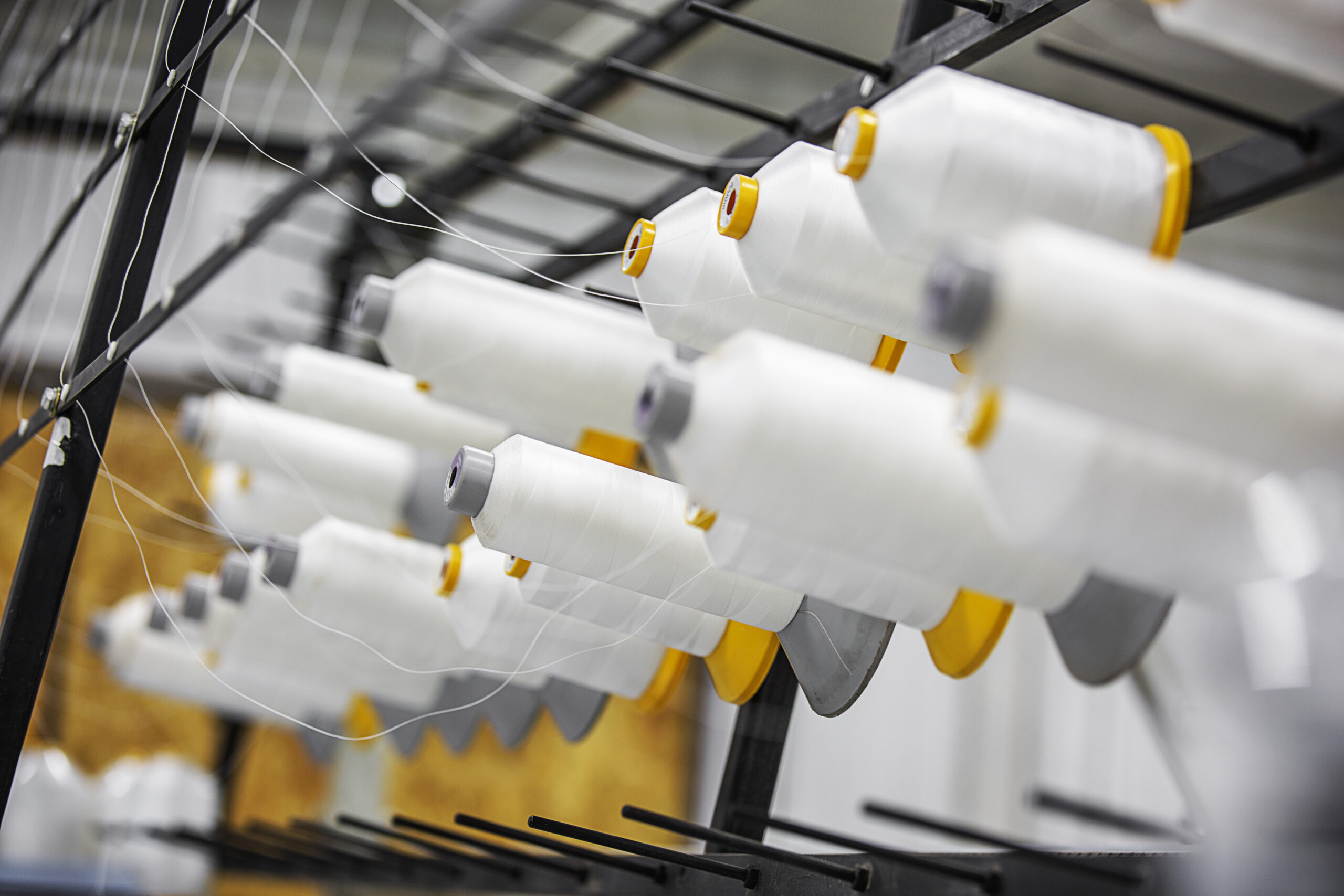Of the 100 billion garments produced each year, 92 million tons end up in landfills. Fast fashion waste is expected to soar up to 134 million tons a year by the end of the decade, according to Earth.org. In addition to creating an overwhelming amount of waste, the fashion industry generates 10% of global carbon emissions and 20% of all wastewater, and it sends half a million tons of microplastics into the oceans. If the fashion industry continues on its current path, by 2050 it could use more than 26% of the carbon budget associated with a 2C global warming limit. Moving away from the current linear and wasteful textiles system is crucial to keep the 2C average global warming limit within reach.
A large part of the problem is that fast fashion brands use cheap fossil-fuel based synthetic materials to keep clothing prices low. As a result, polyester has grown to become the number one synthetic fiber and now represents more than half of all global fiber production. It is derived from nonrenewable sources, requires a great deal of energy for extraction and processing and releases significant byproducts. As an oil-based plastic, polyester does not biodegrade like natural fibers. It stays in landfill for at least several decades.
Despite high-profile attempts at innovation, the fashion industry has so far failed to reduce its footprint in a meaningful way. There are nascent efforts to move to a circular economy, in which polyester can reenter the life cycle rather than being wasted, forming a closed loop that saves resources and reduces environmental impact, but none of them have scaled.
H&M – one of the world’s largest and most recognizable fast fashion brands – and Vargas, a Swedish impact company builder behind H2 Green Steel and Northvolt, say they believe that they have found the right technology and the right team to take on the challenge.
On March 6 they launched Syre, a new venture to scale textile-to-textile recycled polyester. The co-founded venture, also backed by TPG Rise Climate, aims to rapidly scale textile-to-textile recycling of polyester. H&M Group has secured an off-take agreement with Syre worth a total of $600 million over seven years, covering a significant share of H&M Group’s long-term need for recycled polyester, which is currently primarily sourced from rPET bottle-to-textile.
Through Syre, (Sy means to sew in Swedish, a nod to the company’s roots) H&M Group aims to move away from virgin polyester and the current industry standard bottle-to-textile recycling towards a circular economy alternative.
“Syre marks the start of a great textile shift,” Syre CEO Dennis Nobelius said in an interview with The Innovator. “We plan on working across different industry verticals and with competing brands to put textile waste to use, over and over again.”
Headquartered in Stockholm, Syre plans to have 12 plants worldwide by 2034 that will produce a total of over 3 million metric tons per year of polyester fiber recovered from textile waste. H&M’s goal is to source 30% of its material from textile waste by 2025 and 50% by 2030.
About 60 million tons per year of polyester fibers are currently made from fossil fuels, according to Syre. The firm claims that the carbon dioxide footprint of its recycled polyester fiber will be 85% lower than that of virgin polyester and that by 2032 its technology will abate more than 15 million tons of Co2 emissions annually.
From Hong Kong To North Carolina
H&M has been searching for a way to recycle fast fashion for years, a quest that has taken it around the globe. In 2016 the H&M Foundation launched the Recycling Revolution program with The Hong Kong Research Institute of Textiles and Apparel Limited (HKRITA) with the aim to find one commercially viable method that could recycle blended textiles at scale. Blended fabrics—like cotton mixed with polyester – make up 90% of garments but are notoriously difficult to recycle because the fibers are so tightly wound together. Rather than introducing toxic chemicals The H&M Foundation’s Hong Kong project, called The Green Machine, uses hydrothermal technology to break cloth into fibers, which can be recovered. The water in the machine can be reused in a closed loop system. The project has reached several milestones, but its impact has been limited.
In parallel, in 2017 H&M Group invested in RenewCell, a Swedish textile recycling company. RenewCell developed Circulose, a branded dissolving pulp product produced from 100% recycled textiles that can be used as a raw material to produce natural biodegradable textile fibers. The idea was that by replacing virgin textile fibers like cotton with fibers produced from Circulose, fashion brands could reduce the climate and environmental impact caused by raw material extraction and fashion waste generation. In 2020 H&M Group committed to scale up the use of Circulose across its brands over the course of five years. The agreement was hailed as a “significant step forward in the development of a circular economy for fashion.” In February of this year Renewcell filed for bankruptcy, after failing to secure the necessary liquidity and capital to ensure its operations. “This is a sad day for the environment, our employees, our shareholders, and our other stakeholders, and it is a testament to the lack of leadership and necessary pace of change in the fashion industry,” Michael Berg, Renewcell’s Chairman of the Board of Directors, said in a statement.
Weeks later Infinited Fiber Company, a Finnish technology and fashion company with a patented technology that turns cotton-rich textile waste, such as worn-out t-shirts, jeans, and production scraps into Infinna, a virgin-quality, versatile textile fiber with the look and feel of cotton, announced a two-part €40 million funding round, from investors that included H&M. Infinited says its material is biodegradable, contains no microplastics, and at the end of their life, garments made with it can be recycled in the same process together with other textile waste, enabling circularity in fashion.
Earlier this month – the same week the investment in Infinited was announced – H&M revealed its support of Syre. Syre’s technology was developed by “a couple of professors” in North Carolina, says Nobelius, Syre’s CEO. Syre, which has not revealed the identity of the researchers, acquired the technology. “It was at lab scale,” says Nobelius. “They did not have the financial structure, or the muscle, or the expertise to scale.”
Building A Technology Powerhouse For Textiles
The technology developed by the American academics and now owned by Syre uses ethylene glycol to break down polyester into monomers, says Nobelius. The monomers can be used to form new polyester fibers, that are on par with virgin polyester. “We chose this technology because it can take out polyester from any kind of mix of garments,” he says, “and because of the ease of scaling and the cost competitiveness.” While competing processes are energy intensive and/or use a lot of water, the process developed by the North Carolina academics “has very few process steps – 8 or 9 in total – greatly reducing the amount of energy used, it doesn’t require an expensive catalyst and doesn’t use any water,” says Nobelius.
The first plant will be built in North Carolina. It will start with a feedstock mix that is 90% graded polyester. The 10% that is not will be sold to a partner that is interested in using the leftover material to make boxes and packaging, Nobelius says.
He says he believes Syre will become “a technology powerhouse for textiles,” eventually expanding into other fibers. “We are not going to do that in the next year but once you have the ecosystem to secure feed stock it is not that big of a deal to add another fiber or technology,” he says.
Experts say that to really scale textile-to-textile polyester recycling H&M and its partners will have to figure out a way to bring together a high volume, cost-competitive feedstock supply, forge value chain partnerships and offtake agreements and establish the right cost position, a feat that no company in the fast fashion industry has managed to pull off to date.
Nobelius says the off-take agreement with H&M is a good start. ”We will go upstream to match that with feedstock suppliers,” he says, which in Europe and North America include waste management companies, charities and second hand clothing dealers.
The challenge of building such an ecosystem is precisely what attracted Nobelius, to the job. A fashion industry outsider, he spent his career in the auto industry and was part of the founding team of AI Sweden, a national center for applied artificial intelligence.
Until recently Nobelius was Chief Operations Officer (COO) for Polestar, a Swedish automotive manufacturer that produces electric vehicles. He also served as CEO of Zenuity for four years, a software company that develops software for self-driving cars. Prior to Zenuity, Nobelius was MD for Volvo Cars in Switzerland, program leader for the XC90 / S90 / V90 and the new SPA platform for Volvo Car Group, and plant director for the final assembly shop at Volvo Cars Torslanda. He was also CEO for the start-up company Expoplanet and a visiting scholar at Haas School of Business at UC Berkeley in California. He is the initiator and founder of MobilityXlab, a start-up business interface, which orchestrates collaboration between Lindholmen Science Park, big Swedish companies like Ericsson, Zenseact, Volvo Cars, and start-ups from all over the world.
Nobelius was approached by Vargas after being recommended for the job by the CEO of Northvolt. “I never thought I would leave automotive,” says Nobelius. “But the truth of the matter is EVs are happening. There is no debate, but in textile there is this big gap. I was shocked to learned that the industry generates millions of metric tons of waste per year that ends up being incinerated or in landfills and only around 1% is recycled. I decided to do this because I have an opportunity to make an impact.”
Nobelius, who is experienced at scaling companies across the globe, says he is confident that Syre can escape Renewcell’s fate. Experts say the company failed because Circulose cost twice as much as alternative materials and Renewcell was unable to persuade global supply chains to retool in favor of its product.
“Our go-to-market strategy is different, says Nobelius. Syre is also focused on a bigger market, he says. While Renewcell was focused on alternative to virgin cotton, more than 54% of all textile fibers are polyester.
What’s more “the financial structure is completely different,” he says. “We are being backed by a big green climate fund and long-term investors. “
Vargas, the green climate fund that bills itself as an “impact company builder” also backs Northvolt, which aims to deliver batteries with a 90% lower carbon footprint compared to those made using coal energy. The venture has attracted the support of Volvo, BMW Group, Scania and Volkswagen
Lke Northvolt, “we are committed to turning this into an industry movement,” says Nobelius “ It will not be exclusive. We will welcome competing partners to make this happen at scale.”
Syre will also not be limited to fast fashion. It will sell into the auto industry, which uses lots of polyester. “We will provide the material for automotive airbags, carpets, seat belts, upholstery and panels,” he says.
The ambition is there but driving change is tough. Efficient textile waste recycling will require collaboration among all stakeholders in the supply chain, including producers, manufacturers, customers, and governments. As Renewcell discovered, commitments from big players like H&M do not guarantee success. And even if Syre can get the price right the road to circularity is likely to be long. According to the Ellen MacArthur Foundation nearly 97% of clothing materials are derived from virgin resources and only 1% to 3% of recovered materials are recycled textiles.
New technologies offer a chance for the fashion industry to weave a greener future from the threads of the past. To succeed, Syre will have to convince the entire industry to seize the opportunity.
This article is content that would normally only be available to subscribers. Sign up for a four-week free trial to see what you have been missing.
To access more of The Innovator’s Going Green articles click here.






